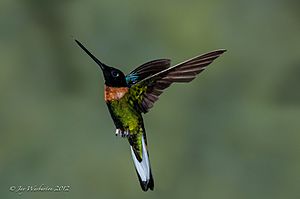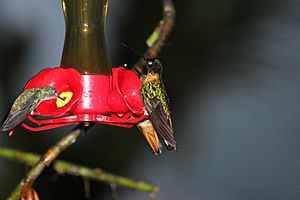Gould's inca facts for kids
Quick facts for kids Gould's inca |
|
|---|---|
 |
|
| At Machu Picchu, Peru | |
| Conservation status | |
| Scientific classification | |
| Genus: |
Coeligena
|
| Species: |
inca
|
The Gould's inca (Coeligena inca) is a type of hummingbird found in the Andes mountains. These tiny, colorful birds live in Bolivia and Peru. They are part of a larger group of birds called "typical hummingbirds."
Contents
About the Gould's Inca
How Scientists Classify This Bird
Scientists who study birds are called ornithologists. They often group animals into different species. Most major bird groups, like the International Ornithological Committee, agree that the Gould's inca is its own unique species.
However, some scientists think it might be a subspecies of the collared inca. A subspecies is like a special type within a species. They are still discussing this idea.
The Gould's inca has two known subspecies:
- C. t. inca (the main one, found by John Gould in 1852)
- C. t. omissa (found by J.T. Zimmer in 1948)
What the Gould's Inca Looks Like
The Gould's inca is about 14.5 centimeters (5.7 inches) long. It weighs between 6.8 and 7.2 grams (about 0.25 ounces). That's about the weight of two pennies!
Male birds of the main subspecies have a mostly black head. They have a green forehead and a small white spot behind each eye. Their back is a shiny golden-green. Their two middle tail feathers are bronze-green, and the others are white with bronze-green tips.
Their throat is black, and they have a bright orange band across their upper chest. Their belly is a sparkling green.
Female birds have a lighter black head with golden-green spots. Their back is also a shining golden-green. Their chest band is more reddish-brown, sometimes with green spots. Their lower belly is green with some reddish-brown and large golden-green spots. Young birds look a lot like adult females.
The subspecies C. t. omissa looks similar but has a bluish forehead. Its throat is greener, and its body feathers are mostly dark green instead of golden-green.
Where They Live
The main subspecies of Gould's inca lives in the Andes mountains of Bolivia. You can find them in the La Paz and Cochabamba areas. The C. t. omissa subspecies lives in the Peruvian Andes. They are found between the Cuzco and Puno regions.
These hummingbirds prefer wet montane forests. This means forests on mountains that get a lot of rain. They usually live in the lower parts of the forest, from 1,600 to 3,200 meters (about 5,200 to 10,500 feet) high.
Behavior and Life Cycle

Movement
Gould's incas usually stay in the same area all year round. They are considered "resident" birds. However, they might make short trips to different places depending on the season.
How They Find Food
Gould's incas are very clever when they look for food. They use a method called "trap-lining." This means they visit a regular path of flowering plants. They remember which flowers they have visited and when they will have more nectar.
They mostly drink nectar from long, tube-shaped flowers. They also eat insects. They catch insects by "hawking," which means flying out from a perch to snatch them in the air. Sometimes, they pick insects off leaves while hovering.
Reproduction
Gould's incas build their nests in a cup shape. They use moss and line it with soft fern scales. Most known nests have been found on sticks or roots. These sticks usually stick out from rocky cliffs under a mossy overhang.
A female Gould's inca usually lays one or two eggs. We don't know how long the eggs take to hatch. However, the young birds usually leave the nest after about 23 days. Only the female bird sits on the eggs and takes care of the baby birds.
Vocalizations
Scientists have not yet fully described the sounds or calls that Gould's inca makes. Some recordings of their calls are included with those of the collared inca. As of early 2023, only one recording of a Gould's inca call was available from a major bird sound library.
Conservation Status
The IUCN (International Union for Conservation of Nature) has listed the Gould's inca as a species of "Least Concern." This means they are not currently in immediate danger of disappearing.
However, their population size is not known, and it is thought to be decreasing. No immediate threats have been found. But their home, the humid montane cloud forest, is facing a lot of destruction. This means the Gould's inca could be in trouble in the future if their habitat continues to shrink.
See also
 In Spanish: Inca de Gould para niños
In Spanish: Inca de Gould para niños


